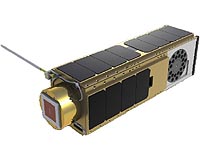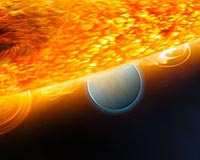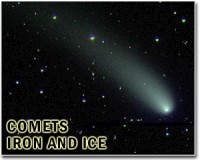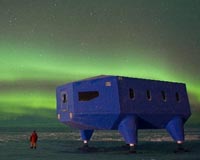|
 Surviving Lunar Dangers
Surviving Lunar DangersSydney, Australia (SPX) Oct 28, 2010 Space takes its toll on humans and equipment. Go into deep space, and the environment becomes even more hostile. Land on the Moon, and you're facing the most dangerous place humans have explored beyond our own world. Most gear that lands on the Moon is only designed to operate for short periods. Sometimes, it's just not worth keeping it functioning for a long time. In other cases, you just can't keep it running. The environment takes its toll. Today, there's nothing on the surface of the Moon that ... read more |
. |
|
|
Free Space, Earth, Energy And Military Newsletters - Delivered Daily |
| . | . |
 Collision Spills New Moon Secrets Scientists led by Brown University are offering the first detailed explanation of the crater formed when a NASA rocket and spacecraft slammed into the Moon last October and information about the com ... more | .. |
 NASA Awards Contract To Team FREDNET Google Lunar X PRIZE Contender Team FREDNET has been awarded a NASA Innovative Lunar Demonstrations Data (ILDD) contract at the maximum government purchase value of $10.01 million. As a recipient of this ILDD contract, Team FREDN ... more | .. |
 Microbes And Molecules Get A Space-Stress Test Astrobiologists searching for life beyond Earth need to know how well life and its building blocks fare in space. To find out, NASA will monitor a miniature "crew" of organic molecules and microbes ... more | .. |
 Planets Discovered Around Elderly Binary Star An international consortium of astronomers, including undergraduate and graduate students at The University of Texas at Austin, have discovered a planetary system consisting of at least two massive ... more | .. |
 New Cometary Phenomenon Greets Approaching Spacecraft Recent observations of comet Hartley 2 have scientists scratching their heads, while they anticipate a flyby of the small, icy world on Nov. 4. A phenomenon was recorded by imagers aboard NASA ... more |
|
Free Space, Earth, Energy And Military Newsletters - Delivered Daily |
| .. |
LRO Supports Historic Lunar Impact Mission Greenbelt MD (SPX) Oct 22, 2010
Greenbelt MD (SPX) Oct 22, 2010The lunar rocks brought back to the Earth by the Apollo astronauts were found to have very little water, and to be much drier than rocks on Earth. An explanation for this was that the Moon formed billions of years ago in the solar system's turbulent youth, when a Mars-sized planet crashed into Earth. The impact stripped away our planet's outer layer, sending it into orbit. The pieces later ... more LRO Detects Surprising Gases In LCROSS Lunar Impact Plume  Boulder CO (SPX) Oct 22, 2010
Boulder CO (SPX) Oct 22, 2010NASA's Lunar Reconnaissance Orbiter (LRO) and its sophisticated suite of instruments have determined that hydrogen, mercury and other volatile substances are present in permanently shaded soils on the Moon, according to a paper published in Science. The Lunar Crater Remote Observation and Sensing Satellite (LCROSS), which launched with LRO, was intentionally crashed onto the Moon's surface ... more Picometre Precision Demonstrated By LISA Pathfinder Tests  Paris, France (SPX) Oct 22, 2010
Paris, France (SPX) Oct 22, 2010A European team working on the LISA Pathfinder mission has completed an extensive series of ground tests on the spacecraft's optical payload. The tests successfully achieved - for the first time on a spacecraft instrument - the incredible precision that will be required to confirm the existence of gravitational waves. The extremely precise measurements are realised by a laser interferomete ... more |
.. |
 New Research Settles Years Debate Over Diffuse Aurora  NASA Open Government Summit Emphasized Data Exchange  Instant online solar energy quotes Solar Energy Solutions from ABC Solar |
.. |
|
|
Free Space, Earth, Energy And Military Newsletters - Delivered Daily |
|
|
. |
 Spring Has Sprung ... On Titan
Spring Has Sprung ... On TitanPasadena CA (SPX) Oct 22, 2010 NASA's Cassini spacecraft has sent back dreamy raw images of Saturn's moon Titan that show the appearance of clouds around the moon's midsection. These bright clouds likely appeared because the moon is changing seasons and spring has arrived in Titan's northern hemisphere. The images were taken from about 2.5 million kilometers (1.5 million miles) away from Titan on Oct. 18, 2010, and also show the faint etchings of Saturn's rings. One of the new raw images also features a cameo from t ... read more |
| The contents herein, unless otherwise known to be public domain, are Copyright 1995-2010 - SpaceDaily. AFP and UPI Wire Stories are copyright Agence France-Presse and United Press International. ESA Portal Reports are copyright European Space Agency. All NASA sourced material is public domain. Additional copyrights may apply in whole or part to other bona fide parties. Advertising does not imply endorsement, agreement or approval of any opinions, statements or information provided by SpaceDaily on any web page published or hosted by SpaceDaily. Privacy statement |
|
Free Space, Earth, Energy And Military Newsletters - Delivered Daily |
| Previous Issues | Oct 27 | Oct 26 | Oct 25 | Oct 22 | Oct 21 |